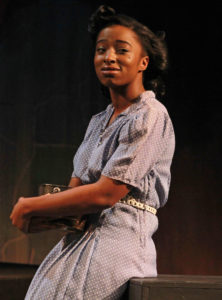

As a black female child, the most powerless character in Morrison’s novel, as she states in her Afterward, this yearning for blue eyes constitutes a way where Pecola’s character exercises agency and challenging the forms of violence, to the point where she actually believes by the end of the novel that she has acquired blue eyes. Where there is subjection, it is important to examine possibilities of intervention, resistance or transformation. Redress constitutes not only as a form of grieving or healing, but an articulation of violence that the subject has encountered.

Does Pecola’s desire for blue eyes have ramifications for the possibility of political resistance to racial oppression? Can this desire serve as not just self-destruction, but a means to articulate extreme violence and subjection?

I hope to use Pecola’s character to expand on my understanding of redress, utilized by Saidiya Hartman in Scenes of Subjection: Terror, Slavery, and Self-Making in Nineteenth-Century America. Blue eyes represent a remedy for the structural violence that she experiences – poverty, domestic violence, and hunger. It is through these moments of “contentment” or “enjoyment,” that we can begin to understand subjection/subjectivity. While Pecola’s desire for blue eyes may be translated as a desire for whiteness and feelings of worthlessness defined by her blackness, I argue that longing for blue eyes constitutes black youth redress. In this paper, I intend on examining Pecola’s body and her hunger for blue eyes as possibilities for redress and resistance, rather than self-destruction. We mustn’t do bad things in front of those pretty eyes” (Morrison, 46). People would look at her and say, “Why look at pretty eyed Pecola. She believes that if she had blue eyes, she would not only be “different” and beautiful, but that she may find love and belonging in her family and community. Her love for Shirley Temple and drinking milk is part of her desire to internalize values of white culture, foreshadowing her yearning for blue eyes. In the beginning of the novel, we learn that Pecola adores Shirley Temple, which represents pure beauty and innocence.

Many of Pecola’s encounters with people throughout the novel validate her perception of her ugliness- schoolboys ridicule her appearance, the grocer ignores her when she tries to purchase candy, and a light-skinned girl, Maureen, who befriends her temporarily, makes fun of her. To possess blue eyes is to possess whiteness.
THE BLUEST EYE CHOLLY FULL
Head full of pretty hair, but Lord was she ugly” (Morrison, 126).Īs Pecola grows up, she longs for blue eyes, a yearning for whiteness, which symbolizes beauty and worth. She characterizes Pecola as a “right smart baby” who knew “right off what to do. In the novel, she reflects back to the moment that Pecola was born and was breastfeeding her. Ideas that her blackness is marked by ugliness and worthlessness get reproduced to her daughter, from the moment that Pecola war born. Her dysfunctional and violent relationship with her husband Cholly reaffirm her belief that she is ugly and that romantic love is reserved for those who are beautiful and valued in society. Pecola’s mother, Pauline, feels isolated and disconnected from her community. This is witnessed very vividly in Pecola’s very household. Morrison presents her central character as the inevitable target of Lorain’s deeply ingrained and multilayered racism, of a community that has absorbs and now replicates destructive dominant cultural myths about beauty and value. While Pecola is the protagonist of the novel, this story is told through the eyes of Claudia MacTeer, a nine year old child whose family takes in Pecola after Pecola’s father, Cholly, burns down their home.
THE BLUEST EYE CHOLLY SERIES
Set in Lorain, Ohio during the 1930s, this book explores the series of abuses that the main character Pecola Breedlove, an eleven year old child, is subjected to, which includes living in harsh poverty, moving from one home to another as a foster child, experiencing rape by her own father, and being ridiculed at school for being an “ugly schoolgirl”. While many texts in American literature engage with the legacy of slavery and the years of deeply-imbedded racism that followed, Toni Morrison’s novel The Bluest Eye focuses specifically on the lingering effects through commentary on internalized racism and black self-hatred.


 0 kommentar(er)
0 kommentar(er)
